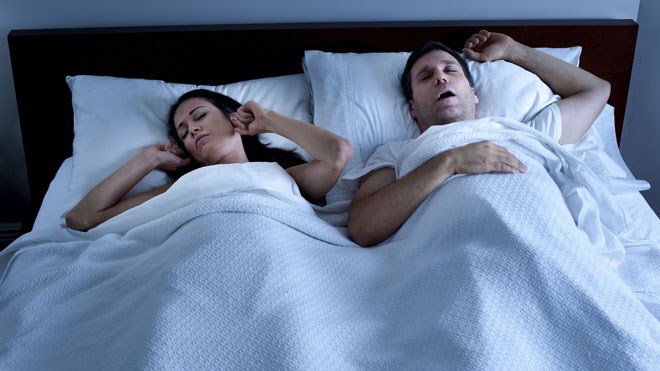Does your partner have obstructive sleep apnea (OSA)? Does he or she have to sleep in another room because of noisy snoring? A snorer is often unaware that this is happening, but the bed partner always notices.
March 2-8 is designated as Sleep Awareness Week.
This is an increasingly common story: a person’s breathing repeatedly stops and starts during sleep. Muscles in the back of the throat relax allowing structures to sag, blocking the flow of air into the lungs. After several seconds, breathing begins again, often with a snore or gasp or choking sound.
This pattern may recur more than 50 times an hour. Naturally, the quality of sleep is significantly diminished.
Other signs of obstructive sleep apnea include excessive daytime sleepiness, difficulty concentrating, memory problems and irritability; waking with a headache and feeling un-refreshed; and waking with a dry mouth.
There may even be abrupt awakenings with shortness of breath and chest pain.
Obstructive sleep apnea (OSA) most commonly affects middle-aged adults.
Of those, twice as many are men. Many are overweight and have a large neck. Smokers are affected more frequently. Alcohol intake, use of sedatives and narcotics may worsen symptoms.
Fifty per cent of patients with type 2 diabetes have OSA.
There are complications accompanying obstructive sleep apnea: heart failure, stroke and high blood pressure. Excessive daytime drowsiness can result in falling asleep at work or even while driving.
Children and young adults experience poor performance at school and may exhibit behavior problems. Extra monitoring needs to be used following general anesthesia.
Diagnosis is important. Visit your family doctor with a sleep diary, documenting bedtime, number of hours slept, nighttime awakenings and symptoms.
Bring a list of your medications and take your bed partner with you. A physical examination including your throat, mouth and nose may be done.
Neck and waist circumference may be measured. Blood pressure will be checked. A sleep study will be arranged, so you can be observed and monitored throughout the night. They check everything: brain waves, eye and jaw movements, airflow, heart rate and rhythm, oxygen blood levels, chest and leg movements.
If the diagnosis of OSA is made, a continuous positive airway pressure machine (CPAP) is prescribed to keep the airway open. It delivers air at pressure through tubing which attaches to a nasal or facemask worn by the patient. You look like Darth Vader, but you sleep like a baby.
Other treatment options include surgery, oral devices and lifestyle modifications like losing weight, exercise and quitting smoking.
Obstructive sleep apnea is totally treatable. If you think you may have it, please see your doctor.
Karen Zalan is a retired physical therapist who worked in pulmonary rehabilitation and asthma education.
Join Sudbury.com+
- Messages
- Post a Listing
- Your Listings
- Your Profile
- Your Subscriptions
- Your Likes
- Your Business
- Support Local News
- Payment History
Sudbury.com+ members
Already a +member?
Not a +member?
Sign up for a Sudbury.com+ account for instant access to upcoming contests, local offers, auctions and so much more.
